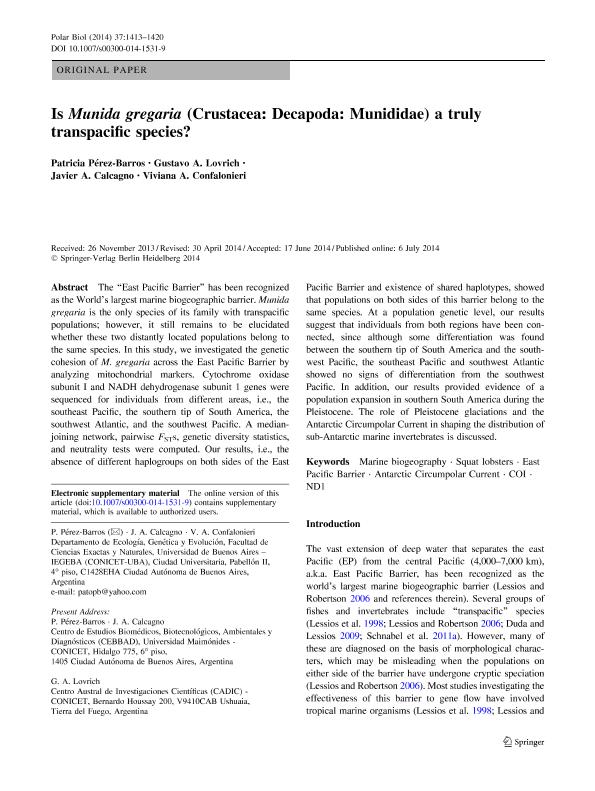Mostrar el registro sencillo del ítem
dc.contributor.author
Perez Barros, Patricia

dc.contributor.author
Lovrich, Gustavo Alejandro

dc.contributor.author
Calcagno, Javier Angel

dc.contributor.author
Confalonieri, Viviana Andrea

dc.date.available
2016-04-15T21:47:31Z
dc.date.issued
2014-12
dc.identifier.citation
Perez Barros, Patricia; Lovrich, Gustavo Alejandro; Calcagno, Javier Angel; Confalonieri, Viviana Andrea; Is Munida gregaria (Crustacea: Decapoda: Munididae) a truly transpacific species?; Springer; Polar Biology; 37; 10; 12-2014; 1413-1420
dc.identifier.issn
0722-4060
dc.identifier.uri
http://hdl.handle.net/11336/5249
dc.description.abstract
The “East Pacific Barrier” has been recognized as the World’s largest marine biogeographic barrier. Munida gregaria is the only species of its family with transpacific populations; however, it still remains to be elucidated whether these two distantly located populations belong to the same species. In this study, we investigated the genetic cohesion of M. gregaria across the East Pacific Barrier by analyzing mitochondrial markers. Cytochrome oxidase subunit I and NADH dehydrogenase subunit 1 genes were sequenced for individuals from different areas, i.e., the southeast Pacific, the southern tip of South America, the southwest Atlantic, and the southwest Pacific. A median-joining network, pairwise F STs, genetic diversity statistics, and neutrality tests were computed. Our results, i.e., the absence of different haplogroups on both sides of the East Pacific Barrier and existence of shared haplotypes, showed that populations on both sides of this barrier belong to the same species. At a population genetic level, our results suggest that individuals from both regions have been connected, since although some differentiation was found between the southern tip of South America and the southwest Pacific, the southeast Pacific and southwest Atlantic showed no signs of differentiation from the southwest Pacific. In addition, our results provided evidence of a population expansion in southern South America during the Pleistocene. The role of Pleistocene glaciations and the Antarctic Circumpolar Current in shaping the distribution of sub-Antarctic marine invertebrates is discussed.
dc.format
application/pdf
dc.language.iso
eng
dc.publisher
Springer

dc.rights
info:eu-repo/semantics/openAccess
dc.rights.uri
https://creativecommons.org/licenses/by-nc-sa/2.5/ar/
dc.subject
Marine Biogeography
dc.subject
Squat Lobsters
dc.subject
East Pacific Barrier
dc.subject
Antarctic Circumpolar Current
dc.subject
Coi
dc.subject
Nd1
dc.subject.classification
Ecología

dc.subject.classification
Ciencias Biológicas

dc.subject.classification
CIENCIAS NATURALES Y EXACTAS

dc.title
Is Munida gregaria (Crustacea: Decapoda: Munididae) a truly transpacific species?
dc.type
info:eu-repo/semantics/article
dc.type
info:ar-repo/semantics/artículo
dc.type
info:eu-repo/semantics/publishedVersion
dc.date.updated
2016-05-06 15:52:43.262787-03
dc.journal.volume
37
dc.journal.number
10
dc.journal.pagination
1413-1420
dc.journal.pais
Alemania

dc.journal.ciudad
Berlin
dc.description.fil
Fil: Perez Barros, Patricia. Consejo Nacional de Investigaciones Científicas y Técnicas. Oficina de Coordinación Administrativa Ciudad Universitaria. Instituto de Ecología, Genética y Evolución de Buenos Aires; Argentina
dc.description.fil
Fil: Lovrich, Gustavo Alejandro. Consejo Nacional de Investigaciones Científicas y Técnicas. Centro Austral de Investigaciones Científicas; Argentina
dc.description.fil
Fil: Calcagno, Javier Angel. Consejo Nacional de Investigaciones Científicas y Técnicas. Oficina de Coordinación Administrativa Ciudad Universitaria. Instituto de Ecología, Genética y Evolución de Buenos Aires; Argentina
dc.description.fil
Fil: Confalonieri, Viviana Andrea. Consejo Nacional de Investigaciones Científicas y Técnicas. Oficina de Coordinación Administrativa Ciudad Universitaria. Instituto de Ecología, Genética y Evolución de Buenos Aires; Argentina
dc.journal.title
Polar Biology

dc.relation.alternativeid
info:eu-repo/semantics/altIdentifier/url/http://link.springer.com/article/10.1007%2Fs00300-014-1531-9
dc.relation.alternativeid
info:eu-repo/semantics/altIdentifier/doi/10.1007/s00300-014-1531-9
dc.relation.alternativeid
info:eu-repo/semantics/altIdentifier/doi/http://dx.doi.org/10.1007/s00300-014-1531-9
Archivos asociados
